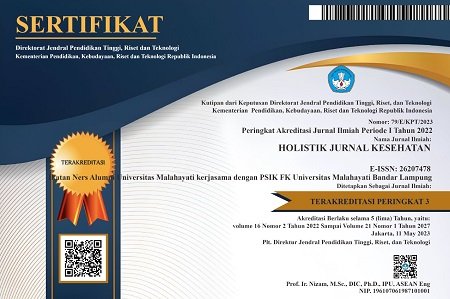Continuous glucose monitoring for hypoglycemia and diabetic ketoacidosis risk reduction among diabetic patient using insulin: A literature review
Abstract
Background: Hypoglycemia and diabetic ketoacidosis (DKA) are the two most common complications in diabetes patients. Monitoring blood glucose levels to prevent acute complications is an important part of diabetes management. In the era of increasingly advanced technology, technology can be used to monitor blood glucose, namely continuous glucose monitoring (CGM).
Purpose: To provide an overview of the effectiveness of using CGM devices as diabetes management to reduce the incidence of hypoglycemia and DKA in diabetes patients receiving insulin therapy.
Method: Literature review research to identify through a database all articles related to the topic of the effectiveness of continuous glucose monitoring (CGM). Literature search using boolean search with population "Diabetes Type 1" OR "Diabetes Patients" OR "Diabetes Type II", Intervention "Flash Glucose Monitoring" OR "Continuous Glucose Monitoring" OR "Real Time Glucose Monitoring", and outcome: "Hypoglycemia" OR “Diabetic Ketoacidosis” OR “Complications” OR “Diabetes Management”.
Results: Identified 360,710 articles and found 15 suitable articles, of which 7 articles discussed that CGM can reduce the incidence of hypoglycemia, 7 articles discussed that CGM installation was related to reducing HbA1C, and 2 articles proved that CGM was related to reducing the incidence of DKA.
Conclusion: The use of CGM effectively and efficiently helps nurses in monitoring blood glucose levels while in the inpatient room in the management of diabetes patients so that it is easier to detect the possibility of hypoglycemia and prevent DKA due to ongoing hyperglycemia.
Suggestion: It is hoped that further research can compare the effectiveness of using CGM equipment based on various types or models.
Keywords: Blood Glucose Monitoring; Continuous Glucose Monitoring; Diabetic Ketoacidosis; Hyperglycemia.
Pendahuluan: Hipoglikemia dan diabetic ketoacidosis (DKA) merupakan dua komplikasi paling sering terjadi pada pasien diabetes. Pemantauan kadar glukosa darah sebagai pencegahan komplikasi akut menjadi bagian penting dalam manajemen diabetes. Di era teknologi yang semakin maju, penggunaan teknologi dapat digunakan sebagai pemantauan glukosa darah yaitu continuous glucose monitoring (CGM).
Tujuan: Untuk memberikan gambaran efektivitas penggunaan alat CGM sebagai manajemen diabetes untuk menurunkan kejadian hipoglikemia dan DKA pada pasien diabetes yang mendapat terapi insulin.
Metode: Penelitian literature review untuk melakukan identifikasi melalui basis data dari semua artikel berkaitan dengan topik efektivitas continuous glucose monitoring (CGM). Pencarian literatur menggunakan boolean search dengan population “Diabetes Type 1” OR “Diabetes Patient” OR “Diabetes Type II”, Intervention “Flash Glucose Monitoring” OR “Continuous Glucose Monitoring” OR “Real Time Glucose Monitoring”, dan outcome: “Hypoglycemia” OR “Diabetic Ketoacidosis” OR “Complications” OR “Diabetes Management”.
Hasil: Mengidentifikasi sebanyak 360.710 artikel dan mendapatkan 15 artikel yang sesuai dimana 7 artikel membahas CGM dapat menurunkan kejadian hipoglikemia, 7 artikel membahas pemasangan CGM berkaitan dengan penurunan HbA1C, dan 2 artikel membuktikan CGM berkaitan dengan penurunan kejadian DKA.
Simpulan: Penggunaan CGM efektif dan efisien membantu perawat dalam melakukan pemantauan kadar glukosa darah selama di ruang rawat inap dalam manajemen penanganan pasien diabetes sehingga lebih mudah dalam mendeteksi kemungkinan terjadinya hipoglikemia dan pencegahan DKA akibat hiperglikemia berkelanjutan.
Saran: Diharapkan penelitian selanjutnya dapat membandingkan efektivitas penggunaan alat CGM berdasarkan dari berbagai jenis atau modelnya.
Kata Kunci: Continuous Glucose Monitoring; Diabetic Ketoacidosis; Hiperglikemia; Pemantauan Glukosa Darah.
Keywords
References
Ahmadi, S.S., Westman, K., Pivodic, A., Ólafsdóttir, A. F., Dahlqvist, S., Hirsch, I. B., & Lind, M. (2020). The association between HbA1c and time in hypoglycemia during CGM and self-monitoring of blood glucose in people with type 1 diabetes and multiple daily insulin injections: a randomized clinical trial (GOLD-4). Diabetes Care, 43(9), 2017-2024.
Ajjan, R. A., Jackson, N., & Thomson, S. A. (2019). Reduction in HbA1c using professional flash glucose monitoring in insulin-treated type 2 diabetes patients managed in primary and secondary care settings: a pilot, multicentre, randomised controlled trial. Diabetes and Vascular Disease Research, 16(4), 385-395.
Ajjan, R., Bilir, S. P., Hellmund, R., & Souto, D. (2022). Cost-Effectiveness Analysis of Flash Glucose Monitoring System for People with Type 2 Diabetes Receiving Intensive Insulin Treatment. Diabetes Therapy, 13(11-12), 1933-1945.
Al Hayek, A. A., & Al Dawish, M. A. (2021). Frequency of diabetic ketoacidosis in patients with type 1 diabetes using FreeStyle Libre: a retrospective Chart Review. Advances in Therapy, 38(6), 3314-3324.
Al Hayek, A. A., Robert, A. A., & Al Dawish, M. A. (2021). Effectiveness of the freestyle libre 2 flash glucose monitoring system on diabetes-self-management practices and glycemic parameters among patients with type 1 diabetes using insulin pump. Diabetes & Metabolic Syndrome: Clinical Research & Reviews, 15(5), 102265.
Al Hayek, A., Robert, A. A., & Al Dawish, M. (2021). Impact of the FreeStyle Libre flash glucose monitoring system on diabetes-self-management practices and glycemic control among patients with type 2 diabetes in Saudi Arabia: A prospective study. Diabetes & Metabolic Syndrome: Clinical Research & Reviews, 15(2), 557-563.
American Diabetes Association Professional Practice Committee. (2022). Diabetes technology: standards of medical care in diabetes—2022. Diabetes Care, 45(Supplement_1), S97-S112.
American Diabetes Association. (2022). Standards of Medical Care in Diabetes—2022. Diakses dari: https://www2.diabetes.org/sites/default/files/2022-11/dc22s007.pdf
Bakar, A., Qomariah, S. N., Santoso, C. H., Gustomi, M. P., Syaful, Y., & Fatmawa, L. (2020). Factors the incidence of hypoglycemia in diabetes mellitus patients: A pilot study in the emergency room. Enfermería Clínica, 30, 46-49.
Castellana, M., Parisi, C., Di Molfetta, S., Di Gioia, L., Natalicchio, A., Perrini, S., & Giorgino, F. (2020). Efficacy and safety of flash glucose monitoring in patients with type 1 and type 2 diabetes: a systematic review and meta-analysis. BMJ open diabetes research & care, 8(1).
Contreras, M., Mesa, A., Pueyo, I., Claro, M., Milad, C., Viñals, C., & Conget, I. (2023). Effectiveness of flash glucose monitoring in patients with type 1 diabetes and recurrent hypoglycemia between early and late stages after flash glucose monitoring initiation. Journal of Diabetes and its Complications, 37(8), 108560.
Dewata, D.G.U.B.N., & Novida, H. (2020). Profile of diabetic ketoacidosis patients at regional public hospital dr. Soetomo in 2017. Jurnal Berkala Epidemiologi, 8(3), 301-309.
Furler, J., O'Neal, D., Speight, J., Blackberry, I., Manski-Nankervis, J. A., Thuraisingam, S., & Best, J. (2020). Use of professional-mode flash glucose monitoring, at 3-month intervals, in adults with type 2 diabetes in general practice (GP-OSMOTIC): a pragmatic, open-label, 12-month, randomised controlled trial. The Lancet Diabetes & Endocrinology, 8(1), 17-26.
Galindo, R. J., Migdal, A. L., Davis, G. M., Urrutia, M. A., Albury, B., Zambrano, C., & Umpierrez, G. E. (2020). Comparison of the FreeStyle Libre Pro flash continuous glucose monitoring (CGM) system and point-of-care capillary glucose testing in hospitalized patients with type 2 diabetes treated with basal-bolus insulin regimen. Diabetes Care, 43(11), 2730-2735.
Hásková, A., Radovnická, L., Petruželková, L., Parkin, C. G., Grunberger, G., Horová, E., & Šoupal, J. (2020). Real-time CGM is superior to flash glucose monitoring for glucose control in type 1 diabetes: the CORRIDA randomized controlled trial. Diabetes Care, 43(11), 2744-2750.
Heinemann, L., Freckmann, G., Ehrmann, D., Faber-Heinemann, G., Guerra, S., Waldenmaier, D., & Hermanns, N. (2018). Real-time continuous glucose monitoring in adults with type 1 diabetes and impaired hypoglycaemia awareness or severe hypoglycaemia treated with multiple daily insulin injections (HypoDE): a multicentre, randomised controlled trial. The Lancet, 391(10128), 1367-1377.
Hellmund, R., Weitgasser, R., & Blissett, D. (2018). Cost calculation for a flash glucose monitoring system for adults with type 2 diabetes mellitus using intensive insulin–a UK perspective. European Endocrinology, 14(2), 86.
Hinkle, J. L., & Cheever, K. H. (2013). Study guide for Brunner & Suddarth's textbook of medical-surgical nursing. Lippincott Williams & Wilkins.
International Diabetes Federation. (2021). IDF Diabetes Atlas 10th edition (10th ed.). Diakses dari: https://diabetesatlas.org/idfawp/resource-files/2021/07/IDF_Atlas_10th_Edition_2021.pdf
Jeyam, A., Gibb, F. W., McKnight, J. A., O’Reilly, J. E., Caparrotta, T. M., Höhn, A., & Scottish Diabetes Research Network Epidemiology Group. (2022). Flash monitor initiation is associated with improvements in HbA 1c levels and DKA rates among people with type 1 diabetes in Scotland: a retrospective nationwide observational study. Diabetologia, 65, 159-172.
Kementerian Kesehatan Republik Indonesia. (2018). Riset Kesehatan Dasar Indonesia Tahun 2018. Diakses dari: https://layanandata.kemkes.go.id/katalog-data/riskesdas/ketersediaan-data/riskesdas-2018
Martens, T., Beck, R. W., Bailey, R., Ruedy, K. J., Calhoun, P., Peters, A. L., & MOBILE Study Group. (2021). Effect of continuous glucose monitoring on glycemic control in patients with type 2 diabetes treated with basal insulin: a randomized clinical trial. Jama, 325(22), 2262-2272.
Oskarsson, P., Antuna, R., Geelhoed-Duijvestijn, P., Krӧger, J., Weitgasser, R., & Bolinder, J. (2018). Impact of flash glucose monitoring on hypoglycaemia in adults with type 1 diabetes managed with multiple daily injection therapy: a pre-specified subgroup analysis of the IMPACT randomised controlled trial. Diabetologia, 61, 539-550.
PatientsPikee, S., Khushbu, K., Anupam, P., Manju, P., & Sachin, J. (2021). New Innovation: use of flash glucose monitoring for evaluating glycaemic variability, patient satisfaction and clinical utility in pregnant women with diabetes. The Journal of Obstetrics and Gynecology of India, 71, 136-142.
Pettus, J. H., Zhou, F. L., Shepherd, L., Preblick, R., Hunt, P. R., Paranjape, S., & Edelman, S. V. (2019). Incidences of severe hypoglycemia and diabetic ketoacidosis and prevalence of microvascular complications stratified by age and glycemic control in US adult patients with type 1 diabetes: a real-world study. Diabetes care, 42(12), 2220-2227.
Rouhard, S., Buysschaert, M., Alexopoulou, O., & Preumont, V. (2020). Impact of flash glucose monitoring on glycaemic control and quality of life in patients with type 1 diabetes: A 18-month follow-up in real life. Diabetes & Metabolic Syndrome: Clinical Research & Reviews, 14(2), 65-69.
Tekarli, M., Turner, K., & Witt, D. (2021). Association between Flash Glucose Monitors and A1C: A Retrospective Pre-Post Analysis. Innovations in Pharmacy, 12(3).
Wright Jr, E. E., Kerr, M. S., Reyes, I. J., Nabutovsky, Y., & Miller, E. (2021). Use of flash continuous glucose monitoring is associated with A1C reduction in people with type 2 diabetes treated with basal insulin or noninsulin therapy. Diabetes Spectrum, 34(2), 184-189.
DOI: https://doi.org/10.33024/hjk.v17i10.13305
Refbacks
- There are currently no refbacks.
Copyright (c) 2024 Holistik Jurnal Kesehatan

This work is licensed under a Creative Commons Attribution-NonCommercial 4.0 International License.














